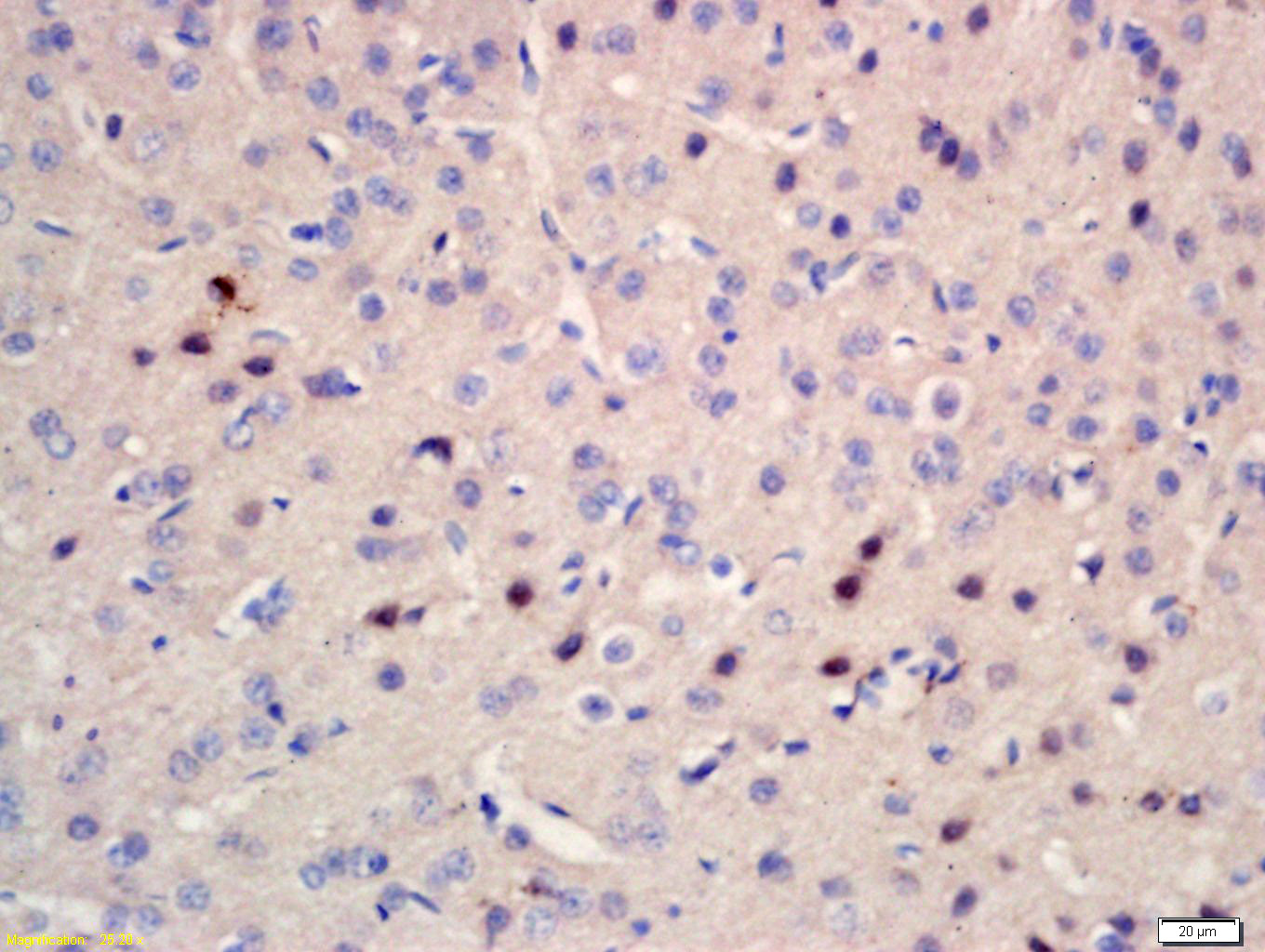CSP Rabbit pAb
CSP Rabbit pAb
- 产品详情
- 实验流程
- 背景知识
Application
| IHC-P, IHC-F, IF |
|---|---|
| Primary Accession | Q9H3Z4 |
| Reactivity | Human, Rat |
| Predicted | Mouse, Pig, Horse, Rabbit, Sheep, Guinea Pig |
| Host | Rabbit |
| Clonality | Polyclonal |
| Calculated MW | 22149 Da |
| Physical State | Liquid |
| Immunogen | KLH conjugated synthetic peptide derived from human CSP |
| Epitope Specificity | 1-100/198 |
| Isotype | IgG |
| Purity | affinity purified by Protein A |
| Buffer | 0.01M TBS (pH7.4) with 1% BSA, 0.02% Proclin300 and 50% Glycerol. |
| SUBCELLULAR LOCATION | Membrane. Melanosome. Identified by mass spectrometry in melanosome fractions from stage I to stage IV. |
| SIMILARITY | Contains 1 J domain. |
| SUBUNIT | Homodimer (Probable). Interacts with the chaperone complex consisting of HSC70 and SGTA (By similarity). |
| Post-translational modifications | Fatty acylated. Heavily palmitoylated in the cysteine string motif. |
| DISEASE | Neuronal ceroid lipofuscinosis 4B (CLN4B) [MIM:162350]: An adult-onset neuronal ceroid lipofuscinosis. Neuronal ceroid lipofuscinoses are progressive neurodegenerative, lysosomal storage diseases characterized by intracellular accumulation of autofluorescent liposomal material, and clinically by seizures, dementia, visual loss, and/or cerebral atrophy. CLN4B has no visual involvement and is characterized by seizures and other neurologic symptoms. Note=The disease is caused by mutations affecting the gene represented in this entry. |
| Important Note | This product as supplied is intended for research use only, not for use in human, therapeutic or diagnostic applications. |
| Background Descriptions | Cysteine string proteins (CSPs) are synaptic vesicle-associated, secretory vesicle proteins that are involved in Ca2+-regulated exocytosis of synaptic vesicles and modulation of presynaptic transmembrane calcium fluxes in neuroendocrine and endocrine cell types. CSP contains a J-domain that binds HSP 70/HSC 70 chaperone ATPases and a membrane-targeting, palmitoylated cysteine-rich string region. CSPs may act as molecular chaperones in synapses, and mediate conformational folding of components of the vesicular exocytotic machinery. CSP is involved in the fine tuning of neurotransmission through its interaction with receptor-coupled trimeric GTP binding proteins (G proteins) and N-type Ca2+ channels. Two variants of CSP have been described: CSP1; and the 31 amino acid, C-terminally truncated isoform, CSP2. Subcellular fractionation of insulinoma cells shows CSP1 in granular fractions, while the membrane and cytosol fractions contain predominantly CSP2. The fractions also contain additional proteins, presumably CSP dimers. Furthermore, in various mammalian cell lines (including rat brain) CSP1 expression predominates CSP2 expression. |
| Gene ID | 80331 |
|---|---|
| Other Names | DnaJ homolog subfamily C member 5, Ceroid-lipofuscinosis neuronal protein 4, Cysteine string protein, CSP, DNAJC5 (HGNC:16235) |
| Target/Specificity | Expressed in pancreas, kidney, skeletal muscle, liver, lung, placenta, brain and heart. |
| Dilution | IHC-P=1:100-500,IHC-F=1:100-500,IF=1:100-500 |
| Storage | Store at -20 °C for one year. Avoid repeated freeze/thaw cycles. When reconstituted in sterile pH 7.4 0.01M PBS or diluent of antibody the antibody is stable for at least two weeks at 2-4 °C. |
| Name | DNAJC5 (HGNC:16235) |
|---|---|
| Function | Acts as a general chaperone in regulated exocytosis (By similarity). Acts as a co-chaperone for the SNARE protein SNAP-25 (By similarity). Involved in the calcium-mediated control of a late stage of exocytosis (By similarity). May have an important role in presynaptic function. May be involved in calcium-dependent neurotransmitter release at nerve endings (By similarity). |
| Cellular Location | Cytoplasm, cytosol {ECO:0000250|UniProtKB:Q29455}. Membrane {ECO:0000250|UniProtKB:Q29455}; Lipid-anchor {ECO:0000250|UniProtKB:Q29455}. Cytoplasmic vesicle, secretory vesicle, chromaffin granule membrane {ECO:0000250|UniProtKB:Q29455}. Melanosome. Cell membrane. Note=The association with membranes is regulated by palmitoylation (By similarity). Identified by mass spectrometry in melanosome fractions from stage I to stage IV (PubMed:17081065). {ECO:0000250|UniProtKB:Q29455, ECO:0000269|PubMed:17081065} |
| Tissue Location | Expressed in pancreas, kidney, skeletal muscle, liver, lung, placenta, brain and heart. |
For Research Use Only. Not For Use In Diagnostic Procedures.
Provided below are standard protocols that you may find useful for product applications.
BACKGROUND
Cysteine string proteins (CSPs) are synaptic vesicle-associated, secretory vesicle proteins that are involved in Ca2+-regulated exocytosis of synaptic vesicles and modulation of presynaptic transmembrane calcium fluxes in neuroendocrine and endocrine cell types. CSP contains a J-domain that binds HSP 70/HSC 70 chaperone ATPases and a membrane-targeting, palmitoylated cysteine-rich string region. CSPs may act as molecular chaperones in synapses, and mediate conformational folding of components of the vesicular exocytotic machinery. CSP is involved in the fine tuning of neurotransmission through its interaction with receptor-coupled trimeric GTP binding proteins (G proteins) and N-type Ca2+ channels. Two variants of CSP have been described: CSP1; and the 31 amino acid, C-terminally truncated isoform, CSP2. Subcellular fractionation of insulinoma cells shows CSP1 in granular fractions, while the membrane and cytosol fractions contain predominantly CSP2. The fractions also contain additional proteins, presumably CSP dimers. Furthermore, in various mammalian cell lines (including rat brain) CSP1 expression predominates CSP2 expression.
REFERENCES
Coppola T.,et al.FEBS Lett. 391:269-272(1996).
Ota T.,et al.Nat. Genet. 36:40-45(2004).
Deloukas P.,et al.Nature 414:865-871(2001).
Mural R.J.,et al.Submitted (SEP-2005) to the EMBL/GenBank/DDBJ databases.
Hattori A.,et al.DNA Res. 7:357-366(2000).
终于等到您。ABCEPTA(百远生物)抗体产品。
点击下方“我要评价 ”按钮提交您的反馈信息,您的反馈和评价是我们最宝贵的财富之一,
我们将在1-3个工作日内处理您的反馈信息。
如有疑问,联系:0512-88856768 tech-china@abcepta.com.























 癌症的基本特征包括细胞增殖、血管生成、迁移、凋亡逃避机制和细胞永生等。找到癌症发生过程中这些通路的关键标记物和对应的抗体用于检测至关重要。
癌症的基本特征包括细胞增殖、血管生成、迁移、凋亡逃避机制和细胞永生等。找到癌症发生过程中这些通路的关键标记物和对应的抗体用于检测至关重要。 为您推荐一个泛素化位点预测神器——泛素化分析工具,可以为您的蛋白的泛素化位点作出预测和评分。
为您推荐一个泛素化位点预测神器——泛素化分析工具,可以为您的蛋白的泛素化位点作出预测和评分。 细胞自噬受体图形绘图工具为你的蛋白的细胞受体结合位点作出预测和评分,识别结合到自噬通路中的蛋白是非常重要的,便于让我们理解自噬在正常生理、病理过程中的作用,如发育、细胞分化、神经退化性疾病、压力条件下、感染和癌症。
细胞自噬受体图形绘图工具为你的蛋白的细胞受体结合位点作出预测和评分,识别结合到自噬通路中的蛋白是非常重要的,便于让我们理解自噬在正常生理、病理过程中的作用,如发育、细胞分化、神经退化性疾病、压力条件下、感染和癌症。






